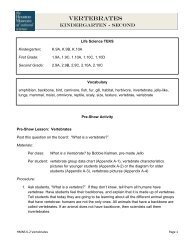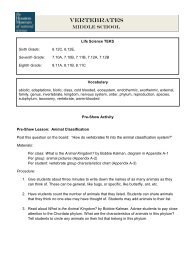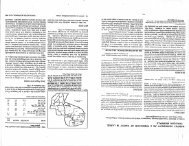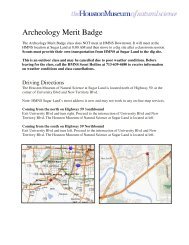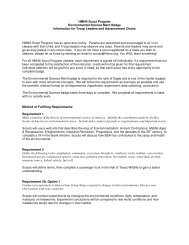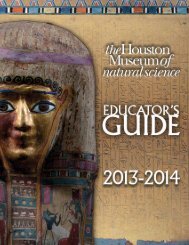Middle School - Houston Museum of Natural Science
Middle School - Houston Museum of Natural Science
Middle School - Houston Museum of Natural Science
You also want an ePaper? Increase the reach of your titles
YUMPU automatically turns print PDFs into web optimized ePapers that Google loves.
Post-Show Enrichment Activities<br />
Activity One: Permineralization Model<br />
Materials: steel wire, copper sulfate, steel wool (don't use the commercial brands <strong>of</strong> steel<br />
wool that are protected from rusting. They will not react).<br />
Procedure:<br />
1. Students will take steel wire and form it into an organism that could be fossilized.<br />
This should be about a two-three inch model <strong>of</strong> that organism.<br />
2. Fill in the body with pieces <strong>of</strong> steel wool.<br />
3. Make a 2% solution <strong>of</strong> copper sulfate.<br />
4. Fill a container with the copper sulfate solution. Immerse the organism half way.<br />
After a few seconds students should notice that the iron in the steel wool is being<br />
replaced by the copper in the solution. It should turn into pink copper wool. The iron<br />
will take the place <strong>of</strong> copper in the solution. This reaction is exothermic and<br />
produces heat.<br />
Activity adapted from Adventures in Paleontology by Thor Hansen and Irwin Slesnick<br />
Explanation:<br />
Most found dinosaur bones are permineralized. Permineralized fossils are created when<br />
spaces in an organism that usually hold liquids or gasses are filled with mineral rich water. This<br />
happens both in an entire organ like a lung and inside individual cells. As mineral rich water<br />
concentrations increase, those minerals precipitate out, filling the voids and surrounding the cell<br />
walls and cell membranes.<br />
Eventually, all carbon-based tissues will rot, completely decomposing. But through a<br />
complicated chemical process called replacement, even things like cell walls and cell membranes<br />
can be preserved by trading their carbon molecules for rock forming minerals. When this happens,<br />
a large amount <strong>of</strong> biological detail is preserved, especially when the replacing minerals differ from<br />
minerals that caused the permineralization. For example, when silica-rich water is the<br />
permineralizing agent and iron pyrite replaces the tissues, paleontologists can see internal cellular<br />
structure. They can even distinguish between different cell organelles! This is only possible when<br />
the fluid space within individual cells is also permineralized. This high quality form <strong>of</strong><br />
permineralization is called petrifaction and commonly occurs in petrified wood. So to be petrified,<br />
objects end up containing none <strong>of</strong> their original chemistry.<br />
Information Source: National Parks Service<br />
HMNS <strong>Middle</strong> <strong>School</strong> Focus on Fossils Page 4




